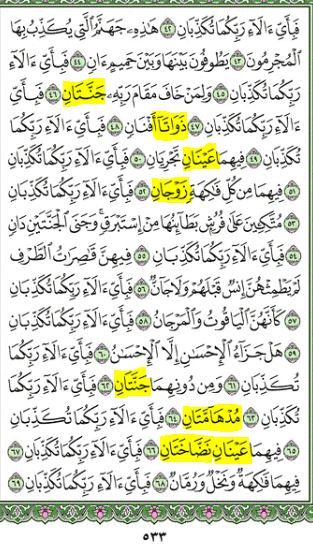
السلام عليكم ورحمة الله وبركاته,
We’ve seen when ضمة (dhammah) and the و will show that a word is in رَفع (raf’). Today we’re going to see how a very unique word shows that it has raf’, and that word is the dual noun. Unlike English, which only has singular and plural, Arabic also has a dual which is used when you’re talking about two things. Forming a dual is very straightforward in Arabic because all you have to do is add انِ (with a single kasrah on to the end of it). For example, adding انِ to the end of رَجُلٌ (“a man”) would get you رَجُلانِ (“two men”).
Substitution of ا for ضمة
ًوَأَمّا الألِفُ فَتَكُوْنُ علَامَةً لِلرَفْعِ فِي تَثْنِيَةِ الأسْماءِ خاصَة
As for the ا (alif), it is a sign of raf’ specifically when doubling the nouns.
ا is an indicator of raf’ in one situation: the dual noun. For example:
حَضَرَ الصَدِيقانِ (“the two friends arrived”)
- صَدِيقان is the dual of صَدِيْقٌ (“friend”)
- It’s in raf’ because it is the doer of the verb حَضَر (“arriving”)
- The sign of raf’ is the ا, substituting for dhammah that we saw at the end of صَديقٌ
- You’d think that the ن would be what shows the status, because it’s the very last letter, but it’s not. The ن will be there for a dual noun in all of its three possible states. As we’ll see later, what would change in the other states is that the ا would become a ي.
- The نِ (with a single kasrah) in the dual is a substitute for the tanween that we saw on صَدِيقٌ
The dual noun is any noun that indicates two masculines or two feminines, using an addition at the end. This addition removes the need for using the same word two times and using “and” between them. For example:
أقبَلَ العُمرانِ وَالهِندانِ (“The two Umars and the two Hinds came”)
The word ٍعُمَران indicates two males, each named Umar, because of the appearance of an addition at the end of it, and this addition is ان. It removes the need for using و (“and”) and repeating the name, so that you wouldn’t have to say حضَر عُمَرُ وَعُمَرُ (“Umar and Umar came”).
Similarly, ِهِنْدان indicates two females, each of them named Hind, because of the appearance ان at the end of it. It removes the need for using و and repeating the name, so that you wouldn’t have to say حَضَرَتْ هنِْدُ وَ هِنْدُ (“Hind and Hind came”).
How duals and masculine plurals behave as a مُضاف
One more thing before we move on to looking at examples in the Quran. We’ve seen that in an idhafah, the tanween or its substitute will drop off the mudhaf (the first word in the phrase).
Some examples of how the tanween or its substitute will drop:
- كِتابٌ (“book”) and زَيدٌ (“Zayd”) – To say “Zayd’s book”:
- You drop the tanween from كِتابٌ to get كِتابُ with just a single dhammah on it
- Put زَيدٌ into jarr by going from to dhammah to kasrah to get زَيدٍ
- You end up with كِتابُ زَيْدٍ (“Zayd’s book”)
- كِتابانِ means “two books” (we added انِ like how talked about before). In duals, the final ن substitutes for the dhammah that was in the singular word. To say “Zayd’s two books”:
- The ن in كِتابانِ substitutes for tanwin. Drop it to get كِتابا
- Put زيدٌ into jarr as before to get زَيْدٍ
- You end up with كِتابا زَيدٍ (“Zayd’s two books”)
- مُسْلِمُونَ (“Muslims”) is the masculine plural of مُسلِمٌ (“Muslim”) that we get by adding ونَ (just like what we saw in Going high with رفع, Part 2: و. To say “the Muslims of Quraysh”:
- The ن in مُسلِمُونَ substitutes for tanwin. Drop it to get مُسلِمُوْ
- Put قُرَيشٌ into jarr and get قُرِيشٍ
- You end up with مًسلِمُوْ قُرَيشٍ (“the Muslims of Quraysh”)
To summarize, if a dual noun or a masculine plural noun is a مُضاف (first word in a possessive phrase), you drop the final ن on it. For other nouns, you drop the tanween on them.
From the Quran
Here’s a page from the Quran (55: 42-69).

- All the highlighted words are dual nouns
- جَنّتانِ is the dual of جَنَّة (“garden”). From this you can tell that if you want to make a dual for a word that ends with ة, you open the ة up into a ت before adding the ِان.
- ذواتا is an example of a dual that is مُضاف and has its final ن dropped.
- There are some words that end in ان but don’t count as duals because the ن doesn’t have a single kasrah
- ءانٍ (Ayah 44), أفنانٍ (Ayah 48), دانٍ (Ayah 54) have a kasrah tanwin on the ن, so that means they’re not duals
- جانٌّ (Ayah 56), المَرجانُ (Ayah 58), الإحْسانُ (Ayah 60) and رُمّانٌ (Ayah 68) are not duals because the ن in them has dhammah on it
- There are other words that do end in انِ but they are not nouns
- تَجرِيانِ (“both of them flow”) in Ayah 50 is actually a verb
- الإِحسانِ (Ayah 60) is a noun. It ends in انِ (and even has a single kasrah), but it’s not a dual. Why not?!? The kasrah on it is not for making a dual, but because it the second word in the possessive phrase جَزاءُ الإحْسانِ (“the reward of excellence”). Remember that the second word of a possessive phrase should have kasrah at the end
Next up إن شاء الله: when ن instead of dhammah is used to show raf’.
Questions
- In how many situations will ا replace dhammah as the sign of raf’?
- What is meant by the مُثّنَّى (dual noun)?
- Give two examples of dual nouns, one masculine and one feminine.
Until next time, السلام عليكم و رحمة الله و بركاته
Like this post? Simply enter your e-mail and click “Yes, include me!” for updates
Leave a Reply